EPIDEMIOLOGY AND CONTAGION
SECTION LINKS:
EPIDEMIOLOGY
Book: Psychiatry of Pandemics: A Mental Health Response to Infection Outbreak, by Damir Huremović, MD, MPP, FACLP
Dr. Huremović is likely the only ACLP member to have edited a book on the psychiatry of infectious epidemics. This link may open a pdf of the book if activated within your institutional network.
https://link.springer.com/book/10.1007/978-3-030-15346-5
Epidemiological incidence tracking
The Financial Times provides this continuously updated reference. This graph shows Covid-19 incidence per 100,000 since the start of the pandemic in the US. A recent increase this month raises the possibility that we may see another winter wave of cases. Data from 12 months ago has been superimposed (shaded line), suggesting the possible course of this exacerbation. This would be grim news for the nation.

At least 4 patterns of Covid-19 incidence were observed in US states. In the northeastern states, onset in the March-April-May of 2020 was followed by a broad winter peak in November-December-January-February, with a late summer rise in July-August-September. Cases are currently rising.

In southern states, there was a strong late summer peak in July-August 2020, followed by a broad winter peak in November-December-January-February (maximum incidence late in winter), and again a late summer rise in July-August-September. Louisiana had a spike of incidence in spring of 2020, perhaps related to holiday festivities. Cases are currently low.

In northern states, there was a sharp early winter peak in November-December 2020, and a late summer rise in July-August-September. Cases are currently rising in some of these areas.

In western states, there was a late summer peak in July-August 2020, followed by a winter peak, followed by a late summer rise in July-August- September. Trends are currently mixed in these areas.
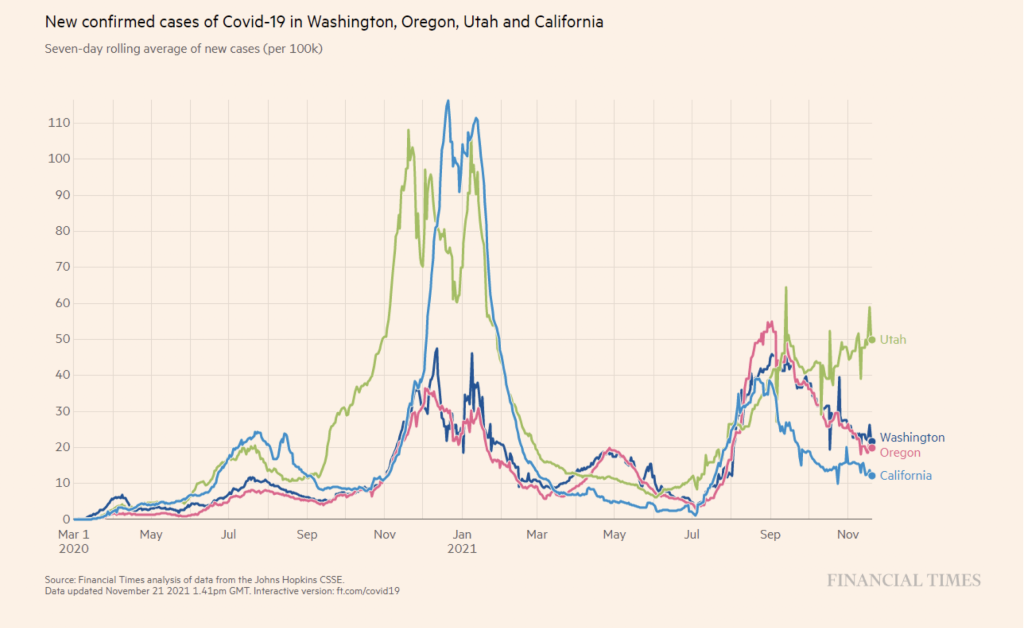
This graph summarizes these four main patterns in the US. States with a late summer rise in 2020 tended to have a larger rise in late summer of 2021. States in the northeast had a spring exacerbation in March-April of 2021; so did Florida, perhaps related to vacation pattern (the strongest spring exacerbation occurred in Michigan, shown in maroon here).
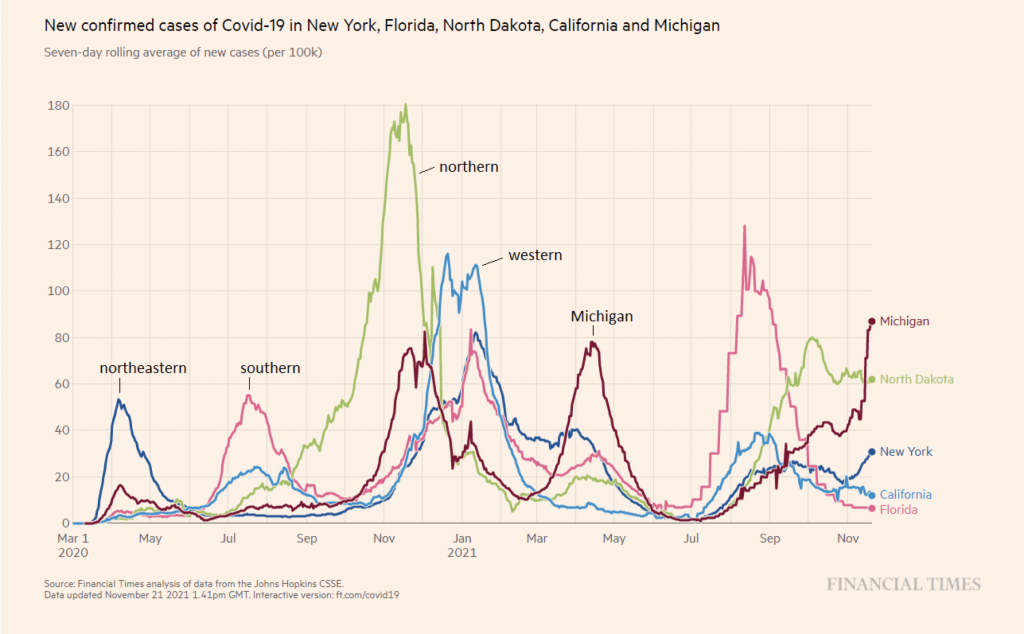
A recent increase in cases is occurring in multiple European countries. This is reminiscent of the pattern in parts of the US as explained above. The UK showed a continued high level of cases since July and the current trend is unclear.

Recent Research Suggests Surgical Masks Inadequate in Clinical Contexts
Recent research raises concerns about the adequacy of protection by surgical masks, implying C-L practitioners should wear N95 gear where virus exposure is possible. Dr Fears et al show that the aerosol efficiency (plaque forming units in aerosol vs solution) of COVID-19 appears to exceed that of SARS or MERS, and also show that aerosol infectivity shows little decay over 16 hours.
https://www.medrxiv.org/content/10.1101/2020.04.13.20063784v1.full.pdf
Dr Chia et al show that airborne particles in the 1 to 4 micron range contain a significant fraction of airborne COVID-19 virus in patient rooms, with maximal levels in the first week of illness. Note that standard surgical masks are not designed to provide efficient protection from particles in this size range.
https://www.medrxiv.org/content/10.1101/2020.03.29.20046557v2.full.pdf
Dr Liu et al find low airborne virus RNA in ventilated negative-pressure patient rooms but find occasional high concentrations in unventilated patient toilet areas, crowded public hospital areas, and areas where staff removed protective gear.
https://www.nature.com/articles/s41586-020-2271-3_reference.pdf
These results are consistent with a randomized clinical trial conducted in winter 2009-10 in Beijing with healthcare workers in emergency or respiratory ward settings, excluding workers with facial hair. Upper respiratory infection rates were 7% with continuous use of N95 respirators and 17% with surgical masks.
https://www.atsjournals.org/doi/full/10.1164/rccm.201207-1164OC?url_ver=Z39.88-2003
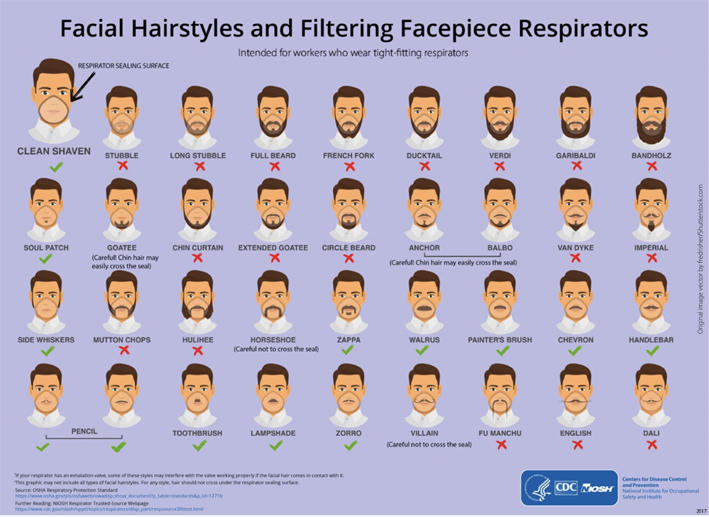 The CDC advises against facial hair in the sealing zones of respirators, a warning likely of greater relevance to psychiatrists than to members of any other medical specialty
The CDC advises against facial hair in the sealing zones of respirators, a warning likely of greater relevance to psychiatrists than to members of any other medical specialty
Summary Accounts of Research on COVID-19 Transmissibility
Erin S. Bromage, PhD, an animal infectious disease researcher at the Department of Biology, University of Massachusetts Dartmouth, has provided clear summaries of the literature on COVID-19 mechanism of spread, patterns of spread, and survival on surfaces (first three links). Jonathan Kay is a journalist and an editor at Quillette, a nonprofit online magazine, and his analysis of superspreader events is the fourth link (see his other blog posts too). Both authors reference the key Chinese study on transmissibility (fifth link).
https://www.erinbromage.com/post/the-risks-know-them-avoid-them
https://www.erinbromage.com/post/where-we-are-now
https://www.erinbromage.com/post/how-do-we-kill-sars-cov2-on-surfaces
https://quillette.com/2020/04/23/covid-19-superspreader-events-in-28-countries-critical-patterns-and-lessons/
https://www.nature.com/articles/s41591-020-0869-5
Early Treatment with Corticosteroids Improves Disease Course
Dr. Raef Fadel, DO, and coworkers at the Henry Ford Hospital describe improved mortality and other disease outcomes with prompt corticosteroid treatment in moderate to severe COVID-19 infection in this quasi-experimental study with 213 subjects.
https://academic.oup.com/cid/advance-article/doi/10.1093/cid/ciaa601/5840526
NEJM Video about Donning and Doffing PPE
Another well-produced video from the NEJM.
https://www.nejm.org/doi/full/10.1056/NEJMvcm2014809
New Review of COVID-19 Psychopharmacology in Psychosomatics
ACLP members Drs. Anna Kim and Carrie Ernst and others provide an analysis of psychopharmacology in the COVID-19 patient.
https://www.sciencedirect.com/science/article/pii/S0033318220301444
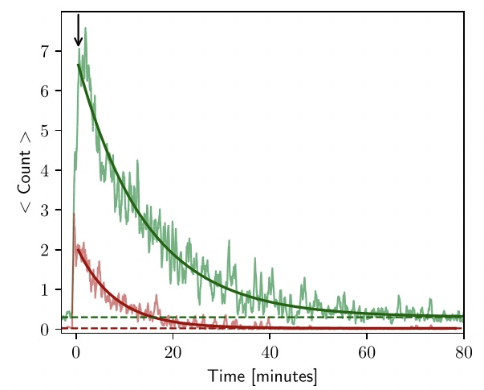 Another Worrisome Study of Aerosol Mechanisms of Infectivity
Another Worrisome Study of Aerosol Mechanisms of Infectivity
Drs. Stadnytskyi et al. estimate the half-life of airborne droplets generated by speech in stagnant air to be 8 to 14 minutes (incidentally, they believe the “th” sound particularly effective for generating such particles).
https://www.pnas.org/content/early/2020/05/12/2006874117
Meta-Analysis of Corona Virus Contagion and Physical Distancing, Mask Use
Chu et al. perform a meta-analysis of 172 studies with SARS, MERS, or COVID-19 contagion, surmising a risk decrease of 82% with one-meter distance (and a two-fold decrease with each additional meter), of 96% with N95 or similar respirators, and of 77% with ordinary face masks. The results strongly argue for use of N95 masks only for all healthcare workers in risk situations.
https://www.thelancet.com/action/showPdf?pii=S0140-6736%2820%2931142-9
Social Disparities in the Impact of COVID-19
Racial, ethnic, and socioeconomic disparities are becoming dramatically obvious in the current pandemic (first link). For example, in New Haven, CT, the rate of COVID-19 infection in the poorest neighborhood area was at one point almost 50 times that in the wealthiest area. A disproportionate impact on black Americans was evident in the 1918 pandemic as well (second link).
https://jamanetwork.com/journals/jama/fullarticle/2764789
https://doi.org/10.7326/M20-2223
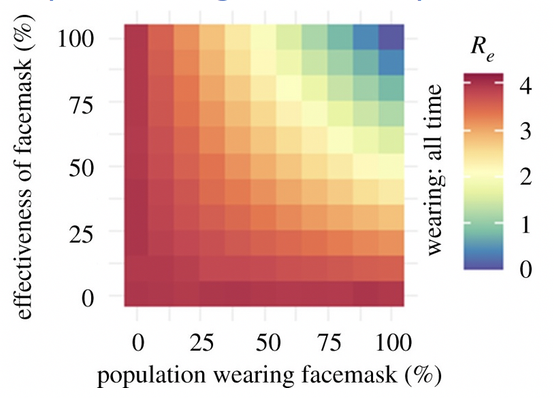 Widespread Mask Use Likely Highly Effective in Reducing Pandemic Spread
Widespread Mask Use Likely Highly Effective in Reducing Pandemic Spread
Richard O. J. H. Stutt et al. present mathematical modelling that even fabric masks could radically decrease Covid-19 spread but only if worn by a high fraction of the population for a high fraction of the time.
https://doi.org/10.1098/rspa.2020.0376
Teenagers Efficiently Transmitter Covid-19
Dr. Young Joon Park et al analyze contact tracing data in South Korea to conclude that Covid+ subjects age 10 to 19 had the highest rate of transmission to housemates compared to any age group, destroying the notion that school reopening will not affect control of the pandemic.
https://wwwnc.cdc.gov/eid/article/26/10/20-1315_article
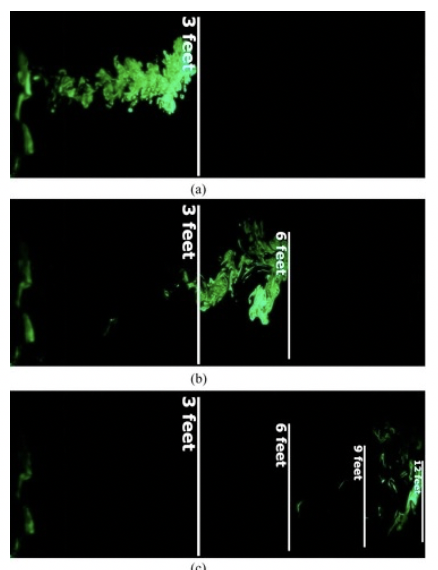 Visualizing and Measuring Droplet Spread with Different Mask Types
Visualizing and Measuring Droplet Spread with Different Mask Types
Drs. Siddhartha Verma, Manhar Dhanak, and John Frankenfield show that without a mask droplets travel up to 12 feet after a simulated cough, but masks of two layers of quilting cotton or a commercial cone mask are highly effective in limiting spread.
https://aip.scitation.org/doi/10.1063/5.0016018
CDC Finds High Covid-19 Seroprevalence in Some Parts of US
Seroprevalence of Covid-19 antibodies was higher than case rates in some areas of the US, eg, as high as 23% in New York City in samples collected in late April to early May. In no part of the country did seroprevalence approach the 60% estimated to be needed for herd immunity.
https://www.cdc.gov/coronavirus/2019-ncov/cases-updates/commercial-labs-interactive-serology-dashboard.html
Aerosol Transmission of Covid-19
Over 200 scientists urge the WHO to emphasize aerosol transmission in this statement which garnered wide attention.
https://academic.oup.com/cid/article/doi/10.1093/cid/ciaa939/5867798
This article in The Atlantic eloquently explains aerosol (floating in air) versus droplet (ballistically propelled but falling to ground) theories about Covid-19 contagion and their policy implications.
https://www.theatlantic.com/health/archive/2020/07/why-arent-we-talking-more-about-airborne-transmission/614737/
A scientific formulation is offered by Dr. Milton here.
https://doi.org/10.1093/jpids/piaa079
Estrogen Protective in Covid-19 Infection
In a new study published in Clinical Infectious Diseases, Dr. T. Ding and co-authors show that age-matched women have lower severity of Covid-19 infection, but this difference disappears after menopause, and also find that estradiol levels are negatively correlated with infection severity and levels of certain cytokines.
https://academic.oup.com/cid/article/doi/10.1093/cid/ciaa1022/5875093
Modeling the Effect of Social Distancing
Dr Sheryl Chang and colleagues model the effect of interventions for slowing pandemic spread in Australia. Social distancing with 90% compliance (yellow solid line) or 80% compliance (orange solid line) are effective but 70% compliance is ineffective (blue solid line), while delaying 3 days reduces effectiveness (dashed lines). Ending social distancing results in rapid resumption of spread.
https://arxiv.org/pdf/2003.10218v2.pdf
![]()
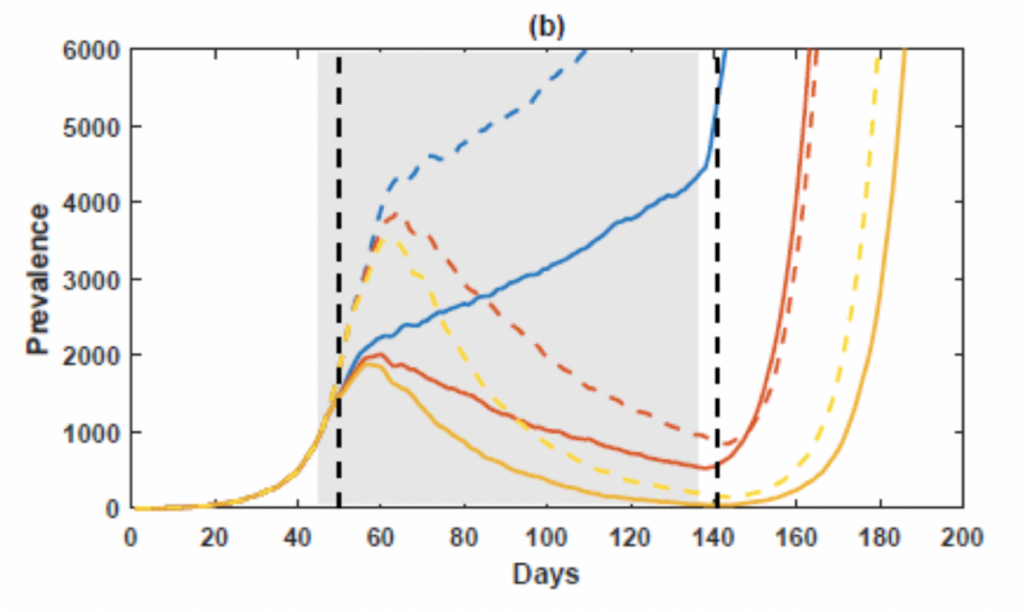
This figure from the NYT emphasizes that social distancing works, but also that most of the US is not successfully applying this strategy.
Low Prevalence of COVID-19 Infection in Iceland Population
Random nasopharyngeal swab testing discloses only 0.8% prevalence of COVID-19 in Iceland, eliminating the hypothesis that a significant fraction of the population had asymptomatic infection. This discouraging finding suggests the pandemic has far to go before population immunity occurs and epidemic spread stops. Interestingly, more men were infected than women, 0.9% vs 0.6%, for which we still have no explanation.
https://www.nejm.org/doi/10.1056/NEJMoa2006100
CIDRAP Report Predicts 18 to 24 Months Duration for COVID-19 Crisis
A report by Dr Michael Osterholm, PhD, MPH, and colleagues from the Center for Infectious Disease Research and Policy (CIDRAP) at the University of Minnesota predicts that COVID-19 will require 18 to 24 months to reach >70% infection rates and subside, and they offer three alternative scenarios of repeated waves of infection, a large wave of infection next fall/winter followed by smaller waves, or continuing variable infection.
https://www.cidrap.umn.edu/sites/default/files/downloads/cidrap-covid19-viewpoint-part1_0.pdf
Grim Effects of Delay in Social Distancing and Other Control Measures
Drs. Sen Pei, Sasikiran Kandula, and Jeffrey Shaman model COVID-19 spread prior to May 3 and estimate that starting control measures one week earlier would have avoided 62% of cases and 55% of deaths in the US. Shown are inter-county commuting data and social distancing impact on effective reproductive number, Re.
https://www.medrxiv.org/content/10.1101/2020.05.15.20103655v1.full.pdf








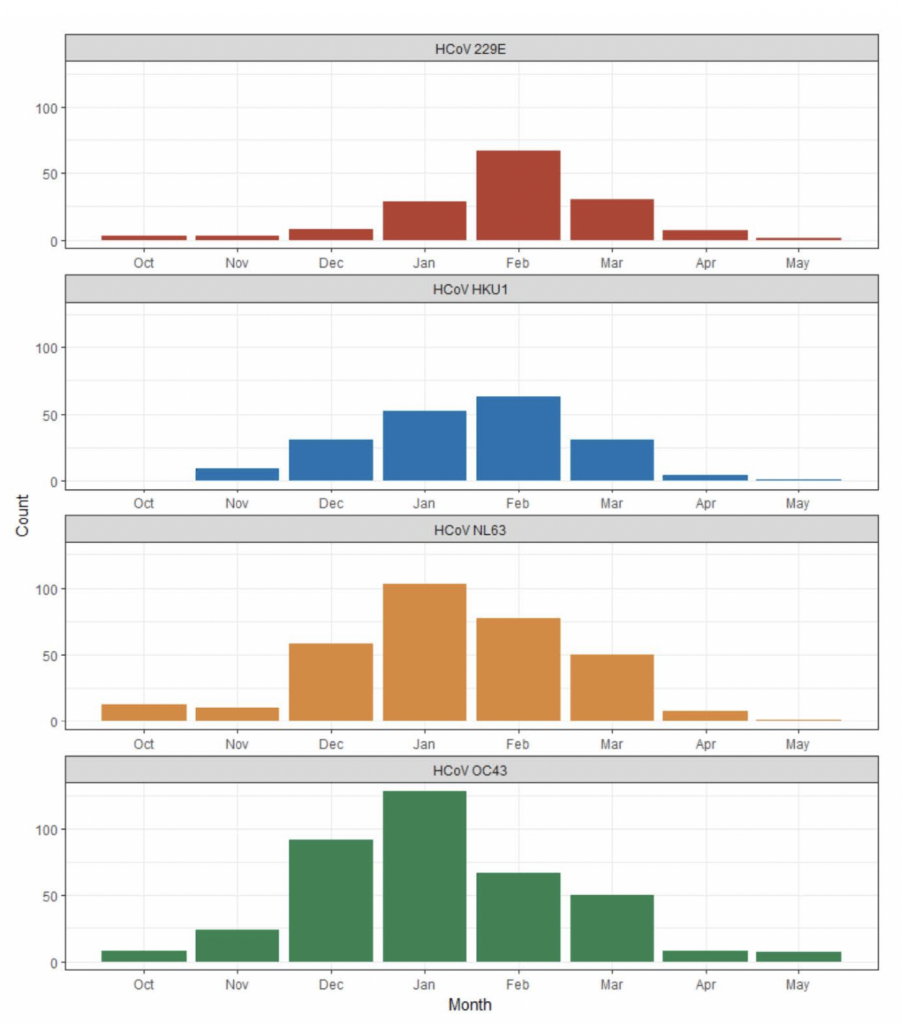

 Another Worrisome Study of Aerosol Mechanisms of Infectivity
Another Worrisome Study of Aerosol Mechanisms of Infectivity Widespread Mask Use Likely Highly Effective in Reducing Pandemic Spread
Widespread Mask Use Likely Highly Effective in Reducing Pandemic Spread Visualizing and Measuring Droplet Spread with Different Mask Types
Visualizing and Measuring Droplet Spread with Different Mask Types